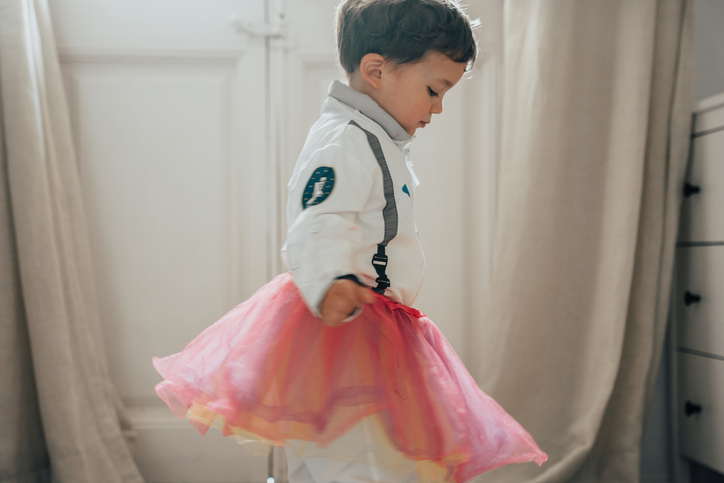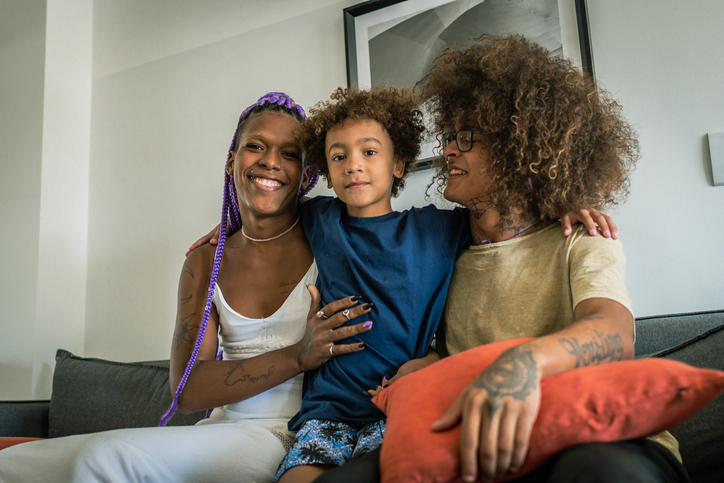Is My Kid Trans or Just Confused? Gender Confusion and Transgender Kids

Your child has come to you and told you that they’re transgender, or maybe they’re questioning their gender and want to explore using a different name or pronouns.
As a parent or caregiver, the most important thing you can do is listen to your child and believe what they tell you. This doesn’t mean that all kids who question their gender identity are transgender, but the biggest way you can support a child’s mental health and well-being is by loving and supporting them unconditionally.
Related: 20 Children’s Books About Transgender and Non-Binary Issues
What is transgender?
Transgender is a term that’s used to refer to someone who does not identify as the gender they were assigned at birth. For example, someone would be considered transgender if they were labeled a girl at birth, but they later identify as a boy or nonbinary person.
There are many terms related to gender and gender identity, which are helpful to know as you learn more about this topic.
- Transgender - An umbrella term used to describe someone who identifies with a different gender than the one they were assigned at birth. This might include identifying as a transman or transwoman, nonbinary, genderqueer, two-spirit, or another gender identity.
- Cisgender - A person who identifies as the gender they were assigned at birth.
- Gender non-conforming - A person whose gender presentation does not fall within stereotypical gender roles. For example, a woman who prefers to wear suits over dresses may be considered gender non-conforming.
- Gender fluid - Someone whose gender identity or gender expression fluctuates and changes over time, whether day-to-day, week-to-week, or every several years.
- Gender identity - A person’s internal sense of their gender, whether male, female or something else.
- Gender expression - A person’s external presentation of their gender, whether masculine, feminine, androgynous or something else. This does not always align with a person’s gender identity. For example, a boy might enjoy wearing dresses and playing with makeup but still identify as a boy.
- Gender transition - Altering one’s gender presentation to align with their gender identity. This can include social transition (e.g., changing name, pronouns, hair, clothing) or medical transition (e.g., surgeries, hormone treatment).
- Gender dysphoria - A sense of distress, discomfort, and unease that a person experiences due to the misalignment between their gender identity and their assigned gender. Gender dysphoria is associated with feelings of depression, anxiety, low self-esteem, and self-harm. Gender transition can help to ease gender dysphoria.
- Transsexual - An outdated term used to describe transgender people. Many trans people reject this term due to its history and use in the medicalization and stigmatization of transgender identity as a mental disorder in the DSM. Although some transgender people do still use this term, many others find it offensive.
Gender confusion in children

It’s common for children and teens to question or explore their gender identity. Children become aware of their gender from a very early age, as young as 2 years old in some cases.
Still, in many cases, it’s common for young people to question their gender identity. Some children who say they are transgender or non-binary may change their minds at some point - just as kids do when trying out a ton of different identities/styles/personalities!
Is my daughter transgender or just a tomboy?
If your child tends to have stereotypically “masculine” traits, does that mean they’re transgender? It may or may not. A girl might enjoy things like rough-housing and baseball and still identify as a girl.
It’s also possible for a tomboy to grow up and later identify as a transman or nonbinary person. If your child has not told you that they’re transgender, the best thing you can do is openly listen to them and let them know that you love them no matter what.
Is being transgender trendy?
No, being transgender isn’t a trend. So why are we hearing more and more about this topic?
Unfortunately, we’re hearing more and more about trans children and gender identity because many bills and laws have recently been introduced to restrict the rights of transgender people. In Texas, legislators have gone as far as to classify gender-affirming healthcare as child abuse.
Far from being a trend, being transgender is an identity that’s rooted in staying true to the deepest sense of one’s self, regardless of external messages.
My daughter wants to be a boy. What should I do?

If your child comes to you and tells you that their gender is something other than the one they were assigned at birth, the most important thing you can do is love and support them. Believe what your child tells you and listen with love and empathy.
If your child comes out to you, you can ask questions about what pronouns they’d like to use or whether they’d like to explore a different hairstyle or clothes. You can also connect with gender-affirming practitioners, like a pediatrician, psychiatrist, or other mental health professional.
What's the difference between gender identity and gender expression?
As mentioned above, gender identity is a person’s internal sense of their gender, while gender expression is someone’s external presentation of their gender.
It’s important to know that gender identity and gender expression don’t always align in ways that we might think. A girl might prefer to wear masculine clothing (gender expression) but still feel that they are a girl (gender identity). A boy might identify as nonbinary (gender identity) but still choose to use he/him pronouns and his birth name (gender expression).
A person’s gender identity also doesn’t determine their sexual orientation. A person can be transgender and identify as gay, straight, lesbian, bisexual, pansexual or any other identity.
Gender transition in children and adolescents

Gender transition refers to a multitude of social, legal, and medical changes that a person undergoes to align their life with their gender identity. Social transition includes things like going by a different name or pronouns, wearing more masculine or feminine clothing, or choosing a different hairstyle. Medical transition includes things like hormone therapy and gender reassignment surgeries. A transgender person may choose to transition in some, all, or none of these areas.
Transgender youth may be prescribed hormone replacement therapy if they choose to do so. Transgender children typically do not transition medically through things like surgery or hormone therapy. At most, a transgender child might be placed on puberty blocker medication which at most delays the onset of puberty and the development of secondary sex characteristics.
Can children de-transition?
Yes, children can de-transition. Typically de-transitioning in children is relatively simple, as children only go through a social transition and not a medical transition. This means that de-transitioning would consist of changing the name and pronouns they go by and changing their physical appearance (e.g., hair, clothes, etc.).
How to support your child's gender identity and exploration

You might feel uncomfortable or out of your depth in supporting your child’s exploration of their gender identity. As a parent or caregiver, here are some ways you can support your child:
- Listen with empathy.
- Ask open-ended questions.
- Allow them to experiment with their clothing and hair.
- Offer to connect with support groups or other social support networks.
- Be open to their pronouns, name, and gender identity changing over time.
- Make space to process your own emotions about your child’s transition, such as with a trusted friend or therapist.
- Correct family members if they use the wrong pronouns or name for your child.
You are your child’s best advocate and support. Regardless of whether your child is transgender or not, when we create more space for kids to be themselves, everybody wins.

